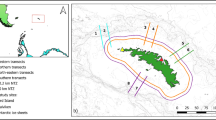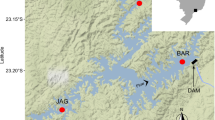Abstract
Biodiversity is currently declining in the Mediterranean, particularly in freshwater ecosystems. The Iberian Peninsula is not an exception with many fish species threatened or endangered. This is the case of Parachondrostoma arrigonis, which has experienced a marked reduction of more than 80 % in both number and area of occupancy in the last 20 years. Species historical records showed a widespread distribution in the Júcar Basin, but according to recent records, P. arrigonis was completely absent in the main river course, being restricted to only some tributaries. Current fish distribution was grouped into only seven fish population nuclei geographically isolated among them. Only two population nuclei showed with well-developed fish populations. Factors affecting P. arrigonis distribution are associated to human activities, such as river channelization, flow regulation, pollution and habitat degradation, being concentrated in the middle and lower river reaches where the Júcar nase is in marked regression. Another key factor was the presence of introduced species, reporting a strong spatial segregation with the translocated Pseudochondrostoma polylepis, an ecologically similar species, and with the exotic piscivorous Micropterus salmoides and Esox lucius, which are currently occupying most of the P. arrigonis historical range. Because its dramatic situation, conservation measures must be urgently taken, for instance, by establishing conservation areas, an exotic fish removal programme, and by developing a flow regulation program to minimize dam effects. However it is necessary to increase our knowledge regarding the habitat requirements of the Júcar nase and its interactions with invasive species. If measures are not implemented its extinction seems inevitable.




Similar content being viewed by others
References
Abell R (2002) Conservation biology for the biodiversity crisis: a freshwater follow-up. Conserv Biol 16:1435–1437
Alcaraz C, Vila-Gispert A, García-Berthou E (2005) Profiling invasive fish species: the importance of phylogeny and human use. Divers Distrib 11:289–298
Alcaraz C, Pou-Rovira Q, García-Berthou E (2008) Use of a flooded salt marsh habitat by an endangered cyprinodontid fish (Aphanius iberus). Hydrobiologia 600:177–185
Aparicio E, Vargas MJ, Ruiz-Olmo J, De Sostoa A (2000) Decline of native freshwater fishes in a Mediterranean watershed on the Iberian Peninsula. Environ Biol Fish 59:11–19
Aparicio E, Carmona-Catot G, Moyle PB, García-Berthou E (2011) Development and evaluation of a fish-based index to assess biological integrity of Mediterranean streams. Aquat Conserv 2:324–337
Bond NR, Lake PS (2003) Characterizing fish–habitat associations in streams as the first step in ecological restoration. Austral Ecol 28:611–621
Britton JR, Gozlan RE, Copp GH (2011) Managing invasive freshwater fish in the environment: a review of global experiences. Fish Fish 12:256–274
Buil JR, Fernández-Yuste JA, Lozano J, Nicolás JI (1987) Datos sobre la distribución de peces en los ríos de la provincia de Cuenca. Ecología 1:231–245
CEN (2003) Water quality – sampling of fish with electricity. EN 14011. European Committee for Standardization, Brussels
Collares-Pereira MJ, Cowx IG, Rodrigues JA, Rogado L, da Costa LM (1999) The status of Anaecypris hispanica in Portugal: problems of conserving a highly endangered species. Biol Conserv 88:207–212
Costa R, Martínez-Capel F, Muñoz-Mas R, Alcaraz-Hernández J, Garófano-Gómez V (2012) Habitat suitability modelling at mesohabitat scale and effects of dam operation on the endangered Júcar Nase, Parachondrostoma arrigonis (River Cabriel, Spain). River Res Appl 28:740–752
Cowx IG, Welcomme RL (1998) Rehabilitation of rivers for fish. Blackwell, Oxford
Cuttelod A, García N, Abdul Malak D, Temple H, Katariya V (2009) The Mediterranean: a biodiversity hotspot under threat. In: Vié JC, Hilton-Taylor C, Stuart SN (eds) Wildlife in a changing world—an analysis of the 2008 IUCN red list of threatened species. IUCN, Gland, pp 89–102
Darwall W, Smith K, Allen D, Seddon M, McGregor Reid G, Clausnitzer V, Kalkman V (2009) Freshwater biodiversity—a hidden resource under threat. In: Vié JC, Hilton-Taylor C, Stuart SN (eds) Wildlife in a changing world – an analysis of the 2008 IUCN red list of threatened species. IUCN, Gland, pp 43–54
Doadrio I, Perea S, Garzón-Heydt P, González JL (2011a) Ictiofauna continental española—bases para su seguimiento. MARM, Madrid
Doadrio I, Aparicio E, Risueño P, Perea S, Pedraza-Lara C, Ornelas-García P, Alonso F (2011b) La loína Parachondrostoma arrigonis (Steindachner, 1866). Situación y estado de conservación. MARM, Madrid
Elvira B, Almodóvar A (2001) Freshwater fish introductions in Spain: facts and figures at the beginning of the 21st century. J Fish Biol 59:323–331
Elvira B, Almodóvar A (2008) Threatened fishes of the world: Chondrostoma arrigonis (Steindachner, 1866) (Cyprinidae). Environ Biol Fish 81:27–28
Filipe AF, Marques TA, Seabra S, Tiago P, Ribeiro F, Costa LMD, Cowx IG, Collares-Pereira MJ (2004) Selection of priority areas for fish conservation in Guadiana River Basin, Iberian Peninsula. Conserv Biol 18:189–200
García-Berthou E, Alcaraz C, Pou-Rovira Q, Zamora L, Coenders G, Feo C (2005) Introduction pathways and establishment rates of invasive aquatic species in Europe. Can J Fish Aquat Sci 62:453–463
Gasith A, Resh VH (1999) Streams in Mediterranean climate regions: abiotic influences and biotic responses to predictable seasonal events. Annu Rev Ecol Evol S 30:51–81
Hooke JM (2006) Human impacts on fluvial systems in the Mediterranean Region. Geomorphology 79:311–335
Lepš J, Šmilauer P (2003) Multivariate analysis of ecological data using CANOCO. Cambridge University Press, Cambridge
Lozano-Rey L (1935) Los peces fluviales de España. Memorias de la Academia de Ciencias Exactas, Físicas y Naturales de Madrid, serie Ciencias Naturales 5:1–390
Ludwig AJ, Reynolds FJ (1988) Statistical ecology: a primer on methods and computing. Wiley, Nueva York
Malmqvist B, Rundle S (2002) Threats to running water ecosystems of the world. Environ Conserv 29:134–153
Marr SM, Impson ND, Tweddle D (2012) An assessment of a proposal to eradicate non native fish from priority rivers in the Cape Floristic Region, South Africa. Afr J Aquat Sci 37:131–142
McCune B (1997) Influence of noisy environmental data on canonical correspondence analysis. Ecology 78:2617–2623
Ninyerola M, Pons X, Roure JM (2005) digital climatic atlas of the Iberian Peninsula. Methodology and applications in bioclimatology and geobotanics. Universidad Autónoma de Barcelona, Barcelona
Olson DM, Dinerstein E, Powell GVN, Wikramanayake ED (2002) Conservation biology for the biodiversity crisis. Conserv Biol 16:1–3
Palmer MA, Liermann CAR, Nilsson C, Flörke M, Alcamo J, Lake PS, Bond N (2008) Climate change and the world’s river basins: anticipating management options. Front Ecol Environ 6:81–89
Perea S, Garzón P, González JL, Almada VC, Pereira AM, Doadrio I (2011) New distribution data on Spanish autochthonous species of freshwater fish. Graellsia 67:91–102
Rahel FJ (2013) Intentional fragmentation as a management strategy in aquatic systems. BioScience 63:362–372
Ramos-Jiliberto R, Valdovinos FS, Arias J, Alcaraz C, García-Berthou E (2011) A network-based approach to the analysis of ontogenetic diet shifts: an example with an endangered, small-sized fish. Ecol Complex 8:123–129
Ribeiro F, Leunda PM (2012) Non-native fish impacts on Mediterranean freshwater ecosystems: current knowledge and research needs. Fisheries Manag Ecol 19:142–156
Robalo JI, Almada VC, Faria C (2003) First description of agonistic behaviour in Chondrostoma polylepis (Pisces: Cyprinidae) with notes on the behaviour of other Chondrostoma species. Etología 11:9–13
Sánchez-Navarro R, Stewardson M, Breil P, GarcíadeJalón D, Eisele M (2007) Hydrological impacts affecting endangered fish species: a Spanish case study. River Res Appl 23:511–523
Santos LN, Agostinho AA, Alcaraz C, Carol J, Santos AFGN, Tedesco P, García-Berthou E (2011) Artificial macrophytes as fish habitat in a Mediterranean reservoir subjected to seasonal water level disturbances. Aquat Sci 73:43–52
Smith KG, Darwall WRT (2006) The status and distribution of freshwater fish endemic to the Mediterranean Basin. IUCN, Gland and Cambridge
Stone L, Roberts A (1990) The checkerboard score and species distributions. Oecologia 85:74–79
Vila-Gispert A, Alcaraz C, García-Berthou E (2005) Life-history traits of invasive fish in small mediterranean streams. Biol Invasions 7:107–116
Acknowledgements
Financial support was provided by the Spanish Ministry of Environment (MMA) through the project CGL2010-231BOS. CA held a postdoctoral contract (DOC-INIA programme) granted by the Spanish National Institute for Agricultural and Food Research and Technology (INIA), Spanish Ministry of Economy and Competitiveness; and GCC held a doctoral fellowship (BR2010/10) from the University of Girona during preparation of the manuscript. We want to thank José Velázquez Cano and Jesús Hernández Núñez de Arenas (Biodiversity Service from the Consellería de Medio Ambiente, Generalitat Valenciana), and Elisabeth Fernández, (URS, United Research Services) for field assistance. Specials thanks are also due to CHJ for data provided. All appropriate ethics and permissions required for the realization of this manuscript were obtained, previously, by the authors.
Author information
Authors and Affiliations
Corresponding author
Rights and permissions
About this article
Cite this article
Alcaraz, C., Carmona-Catot, G., Risueño, P. et al. Assessing population status of Parachondrostoma arrigonis (Steindachner, 1866), threats and conservation perspectives. Environ Biol Fish 98, 443–455 (2015). https://doi.org/10.1007/s10641-014-0274-3
Received:
Accepted:
Published:
Issue Date:
DOI: https://doi.org/10.1007/s10641-014-0274-3




